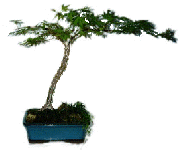Slanting Style
Trees that slant naturally occur a result of buffeting winds or deep shade during early development. Whether curved or straight, the whole trunk leans at a definite angle. The stronger roots grow out on the side, away from the angle of the trunk lean, to support the weight.
Recommended Species: Most species are suitable for this style, as the style does bear similarity to informal upright. Conifers work particularly well.
 Processes/Techniques Used: As mentioned before, this style does bear similarity to informal upright. The trunk can be either curved or straight, but must be on an angle to either the right or left (never to the front), with the apex not directly over the base of the bonsai. This style is quite a simple one that can be achieved by many methods. At an early age, the bonsai can be trained to an angle by means of wiring the trunk until it is in position. Alternatively, the tree can be forced to grow in a slanted style by putting the actual pot on a slant, causing the tree to grow abnormally.
Processes/Techniques Used: As mentioned before, this style does bear similarity to informal upright. The trunk can be either curved or straight, but must be on an angle to either the right or left (never to the front), with the apex not directly over the base of the bonsai. This style is quite a simple one that can be achieved by many methods. At an early age, the bonsai can be trained to an angle by means of wiring the trunk until it is in position. Alternatively, the tree can be forced to grow in a slanted style by putting the actual pot on a slant, causing the tree to grow abnormally.
With formal upright, informal upright and slanted styles, the number three is significant. The lowest branches are grouped in threes, and this grouping begins one-third of the way up the trunk. The bottom-most three branches almost encircle the trunk, with two branches thrusting forward, one slightly higher than the other. The third branch, emanating from a point between the first two, is set at such an angle as to make the foliage appear lower than the other two. This pattern presents an easy way to tell front from back and sets the tone of the entire composition.
The growing tip of a cascade bonsai reaches below the base of a container. The trunk has a natural taper and gives the impression of the forces of nature pulling against the forces of gravity. Branches appear to be seeking the light. The winding main trunk is reminiscent of a stream meandering down the side of a mountain.
Recommended Species: Many species are suitable, if they are not strongly upright.
Processes/Techniques Used: If done right, this style of bonsai can be quite aesthetically pleasing. The trunk which is tapered, grows down below the container and gives the impression of the tree being forced down by the forces of gravity. The tree trunk usually also twists as if to emulate a meandering stream with elegant alternating branches protruding from it.
All that is required to create this style is a tall, narrow pot which will enhance the style and accommodate the cascade and a species of plant that will willingly adopt this style if trained. The main trunk should be wired to spill over and down the edge of the pot, with the main focus on the major bend (forming an upside-down U shape). Emphasis should also be kept on keeping the branches uniform and horizontal to the almost directly vertical trunk. Another major aspect to remember is that both cascade and semi-cascade should be positioned right into the center of the pot, the opposite to what you would do for any other style.
Semi-Cascade Style
 The tip of a semi-cascade, like the cascade, projects over the rim of the container, but does not drop below its base. The style occurs in nature when trees grow on clifs or overhang water. The angle of the trunk in this bonsai is not precise, as long as the effect is strongly horizontal, even if the plant grows well below the level of the pot rim. Any exposed roots should balance the trunk.
The tip of a semi-cascade, like the cascade, projects over the rim of the container, but does not drop below its base. The style occurs in nature when trees grow on clifs or overhang water. The angle of the trunk in this bonsai is not precise, as long as the effect is strongly horizontal, even if the plant grows well below the level of the pot rim. Any exposed roots should balance the trunk.
Recommended Species: Many species are suitable, except strongly upright ones. Flowering cherries, cedars and junipers work well.
Processes/Techniques Used: As the name suggests, a semi-cascade is basically the same as a cascade – involving the same principles, however the tree (growing tip) does not drop below the base of the bonsai pot. Many semi-cascade do not even drop below the edge of the top of the pot. This style is perfect for Junipers.


Deprecated: strpos(): Passing null to parameter #1 ($haystack) of type string is deprecated in /home/agriviek8Qv/agriviet.net/public_html/wp-includes/comment-template.php on line 2522